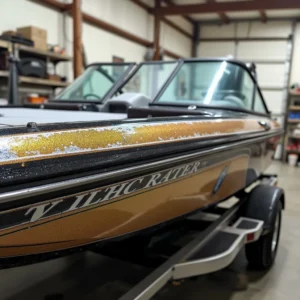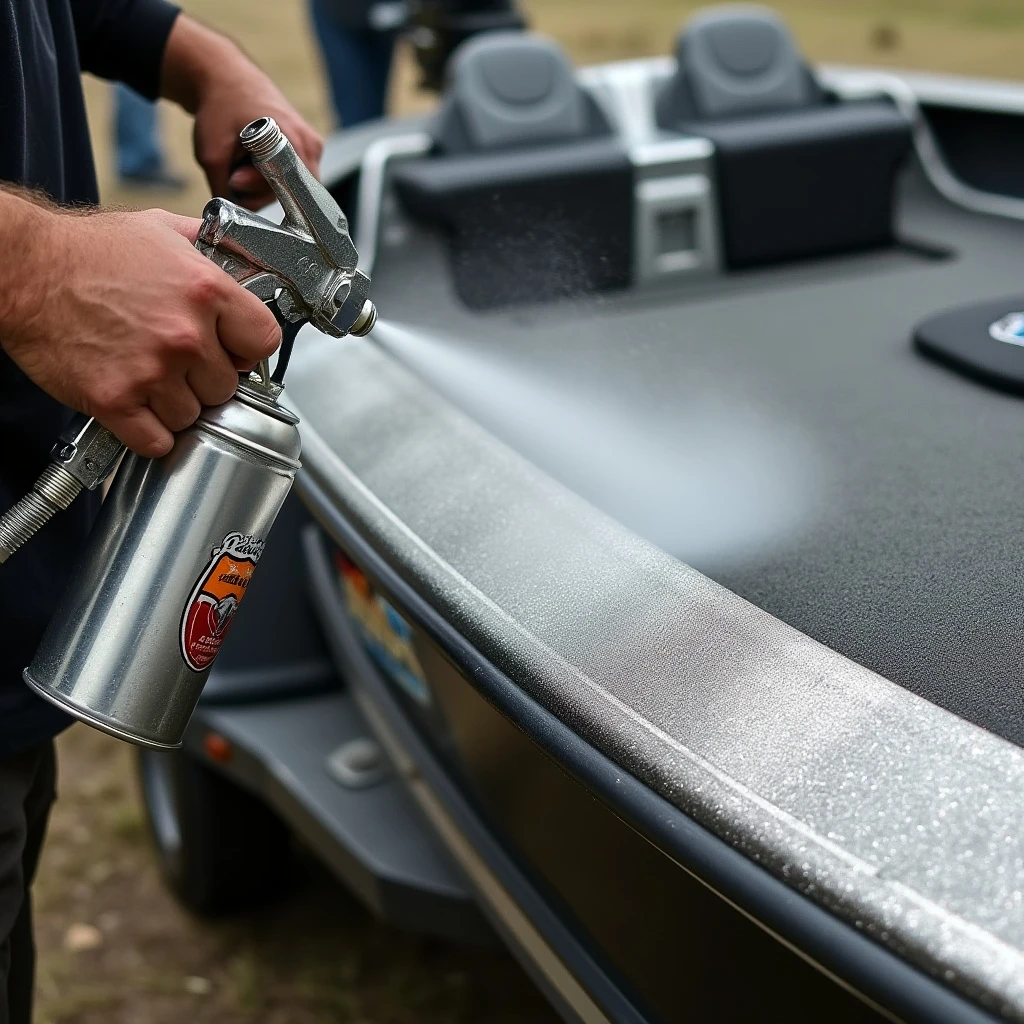Spraying Metal Flake on Bass Boats
Spraying metal flake on your bass boat can give it a professional finish that will turn heads. To achieve this look, there are several steps that must be followed. This guide will take you through the necessary tools and materials that are required, as well as the health and safety considerations that you need to keep in mind before starting.
One of the most important things to keep in mind when spraying metal flake on your bass boat is the importance of achieving a professional finish. This requires careful attention to detail and a steady hand. By following the steps in this guide, you’ll be able to achieve a finish that will rival even the most well-known bass boat brands.
Before you begin spraying metal flake on your boat, it’s important to make sure you have the right tools and materials on hand. This includes things like sandpaper, primer, masks, and metal flakes. You’ll also need to follow certain health and safety precautions to protect yourself from the potentially harmful chemicals involved in the process.
By taking the time to properly prepare your bass boat for metal flake application, you’ll be able to achieve a flawless finish that will last for years to come. From surface preparation and taping to applying the base coat, this guide will provide you with the tools and techniques you need to get the job done right. So, let’s get started!
Preparing Your Bass Boat for Metal Flake Application
Surface Preparation: Cleaning, Sanding, and Priming
Before applying metal flake on your bass boat, it is essential to prepare the surface properly. This involves cleaning, sanding, and priming the surface.
Start by washing your boat with soap and water to remove any grime, dirt, or grease. Next, use a marine cleaner to remove any remaining dirt or residue. Rinse the boat thoroughly with water and allow it to dry.
After cleaning, you need to sand the surface to create an even surface for the metal flake. Use a sandpaper grit of 220 or higher, and sand the entire surface of your boat. Make sure you sand any rough areas evenly.
Once you have sanded the surface, you need to prime it. Using a primer helps create a strong bond between the metal flake and the surface of your boat. Apply a marine-grade primer with a paint roller or spray gun and allow it to dry completely before proceeding.
Taping and Masking Off Areas
After you have prepared the surface, you need to tape and mask off certain areas of your boat to avoid getting metal flake on areas you do not want it.

Use painter’s tape to cover the edges of any metal hardware or trim and the waterline of your boat. Cover the windows, seats, and any other surfaces that do not require the metal flake. Use a plastic masking film to cover large areas.
The Role of Base Coats in Metal Flake Applications
Once you have masked off and prepared the surface, you need to apply a base coat to your boat. The base coat serves as a background color for the metal flake.
Choose a color that complements the metal flake, such as white, silver, or black. Apply the base coat with a spray gun, making sure to cover the entire surface evenly.
Allow the base coat to dry before proceeding with the metal flake application.
Mixing and Applying Metal Flake
A. Choosing the Right Type and Size of Metal Flakes
When it comes to choosing the right metal flake for your bass boat, there are a lot of options to consider. The most common types of metal flakes are aluminum, brass, and copper. Each type of metal flake can give your bass boat a unique look, so it’s important to decide which type of metal flake is the best fit for your personal style. In addition to type, you’ll also need to choose the size of the metal flakes. Smaller flakes will give your finish a smoother appearance, while larger flakes will make your finish more textured.
B. The Perfect Flake to Binder Ratio
When it comes to mixing your metal flakes with your binder, there isn’t a hard and fast rule for the perfect ratio. However, a 1:4 ratio of metal flake to binder is generally considered a good starting point. This ratio allows enough binder to hold the flakes in place while still allowing the flakes to shine through. As you experiment with different ratios, keep in mind that less binder will result in a more textured finish, while more binder will give you a smoother finish.
C. Techniques for Spraying Metal Flake Evenly
The key to applying metal flake evenly is to use a consistent spraying technique. Begin by spraying the metal flake mixture in a crosshatch pattern, making sure to cover the entire surface area. Then, go back over the surface with a few light coats of the mixture, being careful not to oversaturate any one spot. To ensure an even coat, it’s important to keep the nozzle of your spray gun at a consistent distance from the surface of the boat. Additionally, make sure you are using a properly sized spray gun tip. If the tip is too small, you’ll end up with a patchy finish, while a tip that is too large can result in overspray.
Mixing and applying metal flake to your bass boat can be a daunting task, but with the right tools and techniques, you can achieve a professional-looking finish. By choosing the right type and size of flakes, experimenting with different ratios of flakes to binder, and using consistent spraying techniques, you can create a unique and eye-catching metal flake finish for your bass boat.
Sealing and Finishing the Metal Flake Coating
After spraying metal flake on your bass boat, the next step is to seal and finish the coating. This is important for protecting the base coat and metal flake from damage and ensuring a long-lasting, high-gloss finish.
A. Applying Clear Coats for Protection and Shine
The first step in sealing and finishing the metal flake coating is to apply several layers of clear coat. Clear coats are essential for protecting the metal flake and base coat from the elements, such as UV rays, rain, and saltwater. It also gives the finish a high-gloss shine that makes the metal flake really pop.
When applying clear coats, it is best to use a high-quality spray gun to ensure even coverage. You can use a 1.2 to 1.4 mm tip size, depending on the clear coat brand you choose and the weather. It is also essential to use the correct hardener and reducer ratios specified by the manufacturer’s instructions. You should always apply thin and even coats to prevent drips and runs.
B. Drying Times and Curing Process
After applying the clear coats, you must wait for them to dry and cure completely before proceeding. The drying time depends on the type of clear coat and the weather conditions. Typically, you will wait around 24 hours before handling or moving the boat. However, waiting for a full cure can take up to two weeks, depending on the temperature and humidity levels.
C. Wet Sanding and Buffing for a Show-Quality Finish
Once the clear coats have cured, you can wet sand the surface to remove any imperfections, orange peel textures, or dust nibs. Wet sanding should be done very carefully and with the correct grits, starting from 800 and moving up to 2000 grit, then to a polishing compound. After wet sanding, the surface must be buffed using a buffer and a polishing compound. This process will give your metal flake finish a show-quality finish with a mirror-like shine that everyone will notice.
It is essential to follow these steps to ensure proper sealing and finishing of your metal flake coating. Doing this will not only protect your boat’s metal flake from the elements, but it will also make it look amazing.
| Step | Description |
|---|---|
| 1 | Apply several layers of clear coat to protect the metal flake and base coat from elements |
| 2 | Use high-quality spray gun with 1.2 to 1.4 mm tip size and correct hardener and reducer ratios |
| 3 | Wait for clear coats to dry and cure completely before proceeding |
| 4 | Wet sand surface carefully with correct grits (800 to 2000) to remove imperfections, and buff with polishing compound for mirror-like shine |
Maintenance and Care for Your Metal Flake Finish
Once you have successfully applied your metal flake finish, it’s essential to take proper care of it to maintain its shine and color. Here are some tips on how to maintain and care for your metal flake finish:
A. Regular Cleaning and Upkeep
Clean your boat regularly with a mild detergent and soft cloth or sponge to avoid scratching the surface. Avoid using abrasive cleaners or tools that can damage the finish. Rinse the boat thoroughly with water after cleaning, and dry it with a soft cloth or chamois to prevent water spots.
B. Protecting Your Finish from the Elements
Your metal flake finish can fade or discolor over time if exposed to harsh elements such as sun, saltwater, or pollution. To prevent this, you can use protective coatings such as sunblocker or wax to shield it from UV rays, saltwater, and other environmental contaminants. Apply the coating according to the manufacturer’s instructions, and repeat as necessary to maintain optimum protection.
C. Troubleshooting Common Issues with Metal Flake Finishes
If you notice any problems with your metal flake finish, such as peeling, bubbling, cracking, or fading, it’s essential to address them promptly to prevent further damage. Here are some common issues and their possible solutions:
| Issue | Solution |
|---|---|
| Peeling | Sand the affected area, prime it, and reapply the metal flakes and clear coat. |
| Bubbling | Sand the affected area, apply the primer, and reapply the clear coat. |
| Cracking | Remove the affected area, prime it, and reapply the metal flakes and clear coat. |
| Fading | Apply a top coat, such as wax or sunblocker, to protect the finish from UV rays and other environmental factors. Repeat as necessary. |
Frequently Asked Questions
Q: How long does a metal flake finish last?
A: With proper care, a metal flake finish can last for many years. However, its lifespan depends on factors such as the quality of materials used, the application process, and the degree of exposure to environmental conditions.
Q: Can I repaint my metal flakes if I want a different color?
A: Yes, you can repaint your metal flake finish if you want to change the color or design. However, the process involves sanding and priming the existing finish, which can be time-consuming and labor-intensive. Consult an expert for advice on how to repaint your metal flake finish.
Q: Do I need to use a specific type of wax or sunblocker on my metal flake finish?
A: Many manufacturers produce waxes and sunblockers designed specifically for use on metal flake finishes. However, any high-quality wax or sunblocker that provides UV protection and shields the surface from harsh elements can be suitable.










